University Finance Assignment: Comparative Advantage and Tariffs
VerifiedAdded on 2022/08/12
|10
|1855
|18
Homework Assignment
AI Summary
This finance assignment explores the concept of comparative advantage, defining it as a measure of a country's ability to produce goods at a lower opportunity cost than its trading partners. It delves into how tariffs, taxes on imported goods, restrict international trade by increasing the cost of foreign products, potentially leading to trade wars and inefficient domestic industries. The assignment examines the impacts of US tariffs, particularly in 2018, on domestic prices, supply chains, and real income, as well as the implications of trade disputes, such as the WTO ruling on subsidies for aircraft manufacturers. The analysis also covers the impact of tariffs on specific industries like the wine industry, and the potential long-term effects on the American economy. The assignment references various sources including academic journals, government reports and news articles to support the findings.
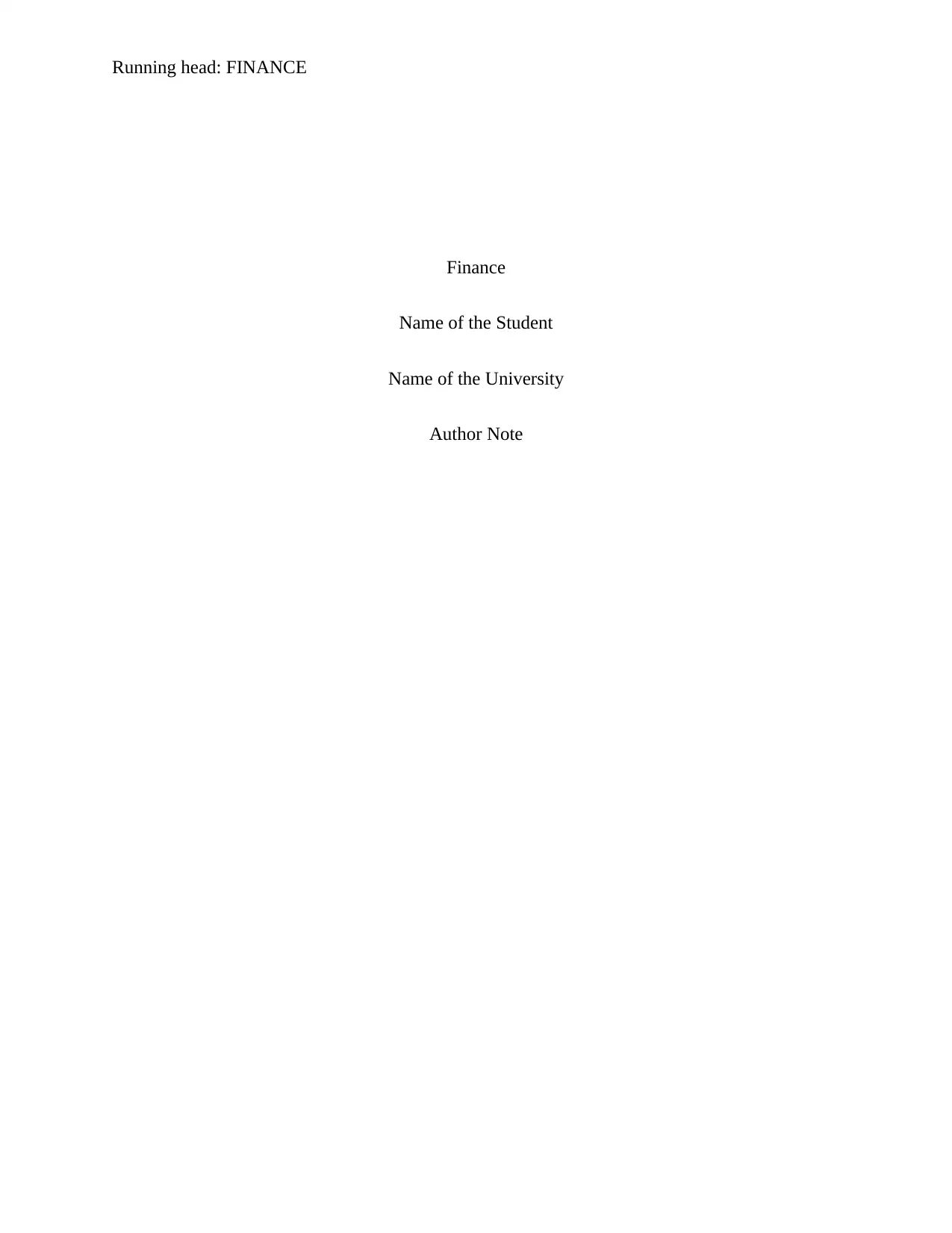
Running head: FINANCE
Finance
Name of the Student
Name of the University
Author Note
Finance
Name of the Student
Name of the University
Author Note
Paraphrase This Document
Need a fresh take? Get an instant paraphrase of this document with our AI Paraphraser
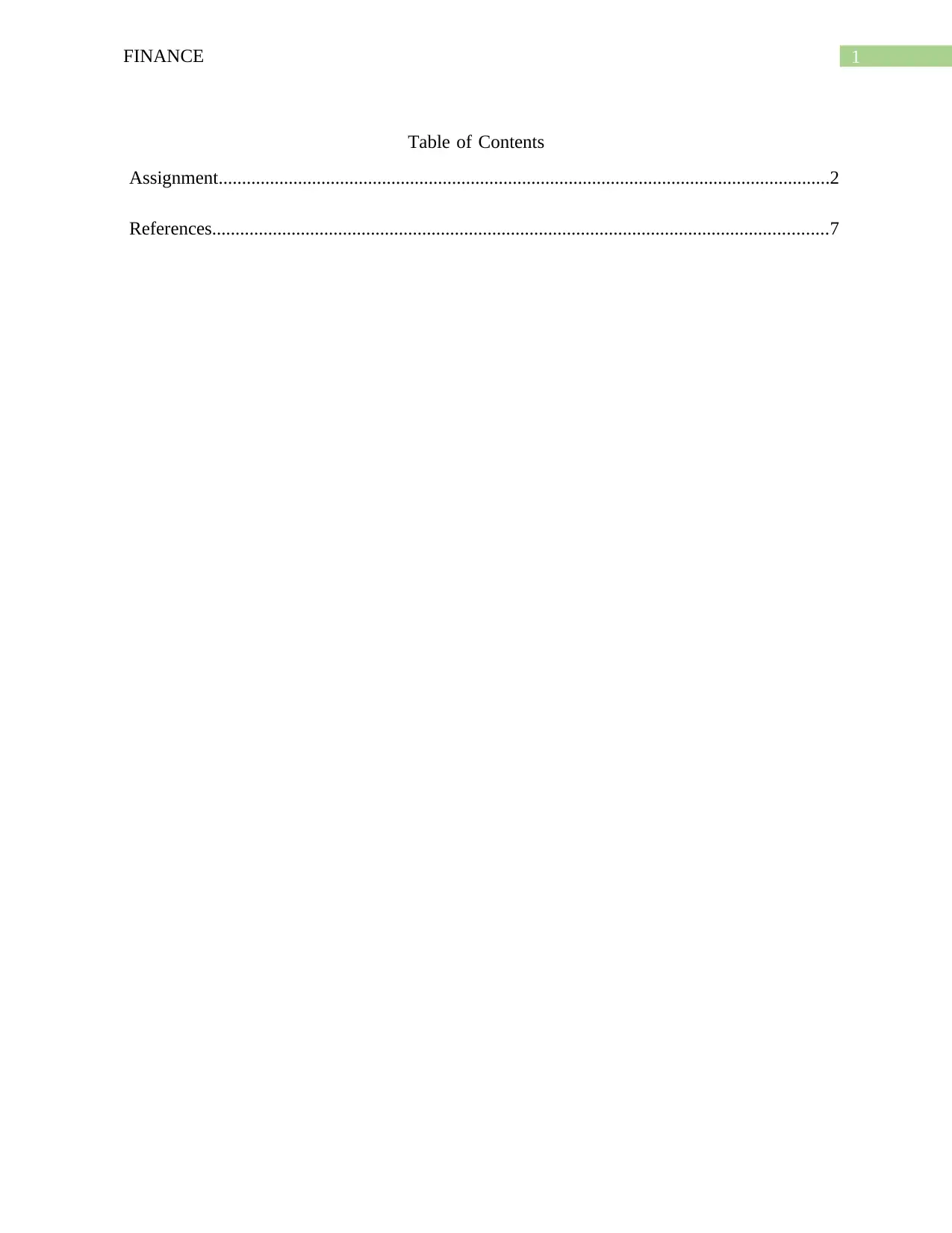
1FINANCE
Table of Contents
Assignment...................................................................................................................................2
References....................................................................................................................................7
Table of Contents
Assignment...................................................................................................................................2
References....................................................................................................................................7
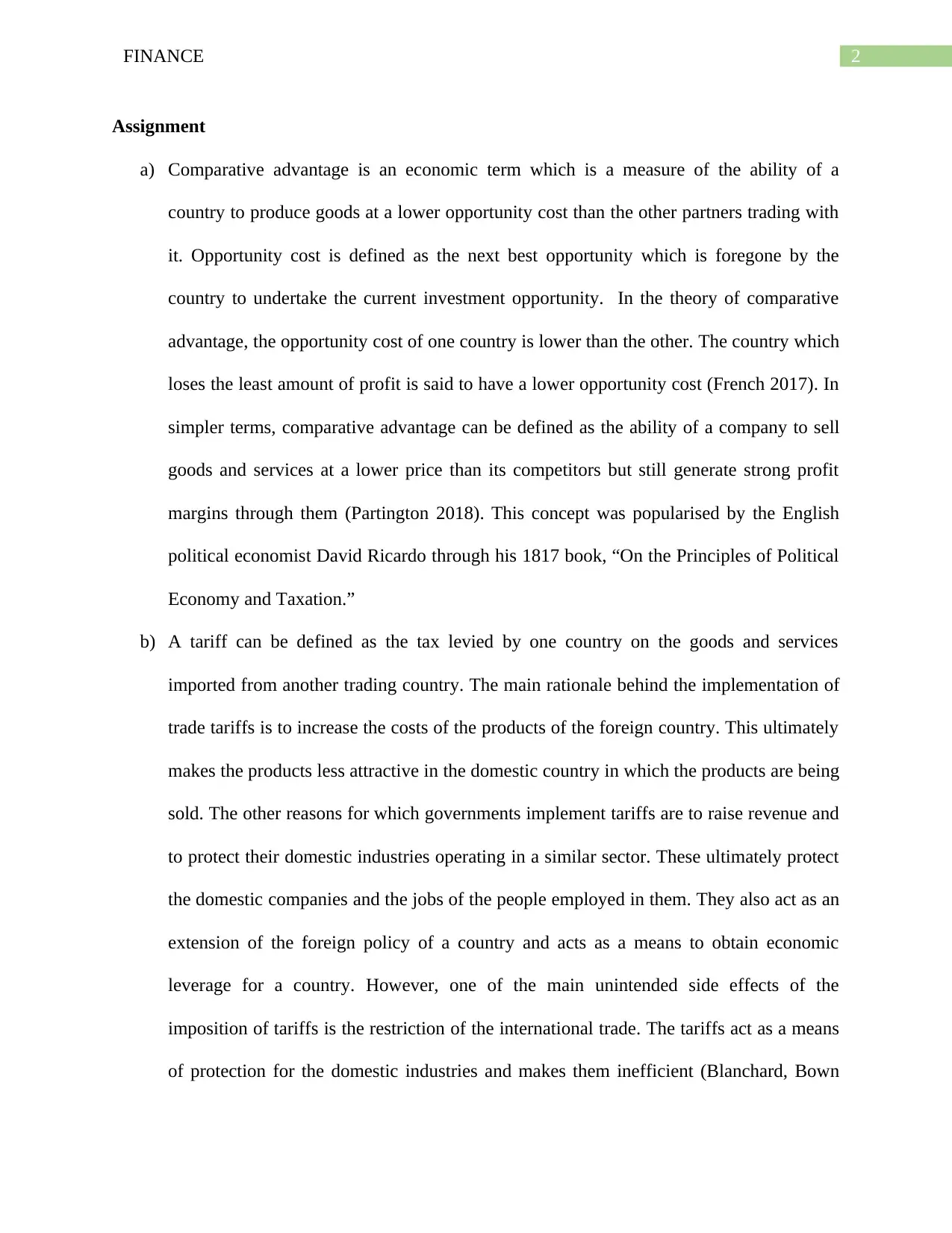
2FINANCE
Assignment
a) Comparative advantage is an economic term which is a measure of the ability of a
country to produce goods at a lower opportunity cost than the other partners trading with
it. Opportunity cost is defined as the next best opportunity which is foregone by the
country to undertake the current investment opportunity. In the theory of comparative
advantage, the opportunity cost of one country is lower than the other. The country which
loses the least amount of profit is said to have a lower opportunity cost (French 2017). In
simpler terms, comparative advantage can be defined as the ability of a company to sell
goods and services at a lower price than its competitors but still generate strong profit
margins through them (Partington 2018). This concept was popularised by the English
political economist David Ricardo through his 1817 book, “On the Principles of Political
Economy and Taxation.”
b) A tariff can be defined as the tax levied by one country on the goods and services
imported from another trading country. The main rationale behind the implementation of
trade tariffs is to increase the costs of the products of the foreign country. This ultimately
makes the products less attractive in the domestic country in which the products are being
sold. The other reasons for which governments implement tariffs are to raise revenue and
to protect their domestic industries operating in a similar sector. These ultimately protect
the domestic companies and the jobs of the people employed in them. They also act as an
extension of the foreign policy of a country and acts as a means to obtain economic
leverage for a country. However, one of the main unintended side effects of the
imposition of tariffs is the restriction of the international trade. The tariffs act as a means
of protection for the domestic industries and makes them inefficient (Blanchard, Bown
Assignment
a) Comparative advantage is an economic term which is a measure of the ability of a
country to produce goods at a lower opportunity cost than the other partners trading with
it. Opportunity cost is defined as the next best opportunity which is foregone by the
country to undertake the current investment opportunity. In the theory of comparative
advantage, the opportunity cost of one country is lower than the other. The country which
loses the least amount of profit is said to have a lower opportunity cost (French 2017). In
simpler terms, comparative advantage can be defined as the ability of a company to sell
goods and services at a lower price than its competitors but still generate strong profit
margins through them (Partington 2018). This concept was popularised by the English
political economist David Ricardo through his 1817 book, “On the Principles of Political
Economy and Taxation.”
b) A tariff can be defined as the tax levied by one country on the goods and services
imported from another trading country. The main rationale behind the implementation of
trade tariffs is to increase the costs of the products of the foreign country. This ultimately
makes the products less attractive in the domestic country in which the products are being
sold. The other reasons for which governments implement tariffs are to raise revenue and
to protect their domestic industries operating in a similar sector. These ultimately protect
the domestic companies and the jobs of the people employed in them. They also act as an
extension of the foreign policy of a country and acts as a means to obtain economic
leverage for a country. However, one of the main unintended side effects of the
imposition of tariffs is the restriction of the international trade. The tariffs act as a means
of protection for the domestic industries and makes them inefficient (Blanchard, Bown
⊘ This is a preview!⊘
Do you want full access?
Subscribe today to unlock all pages.

Trusted by 1+ million students worldwide
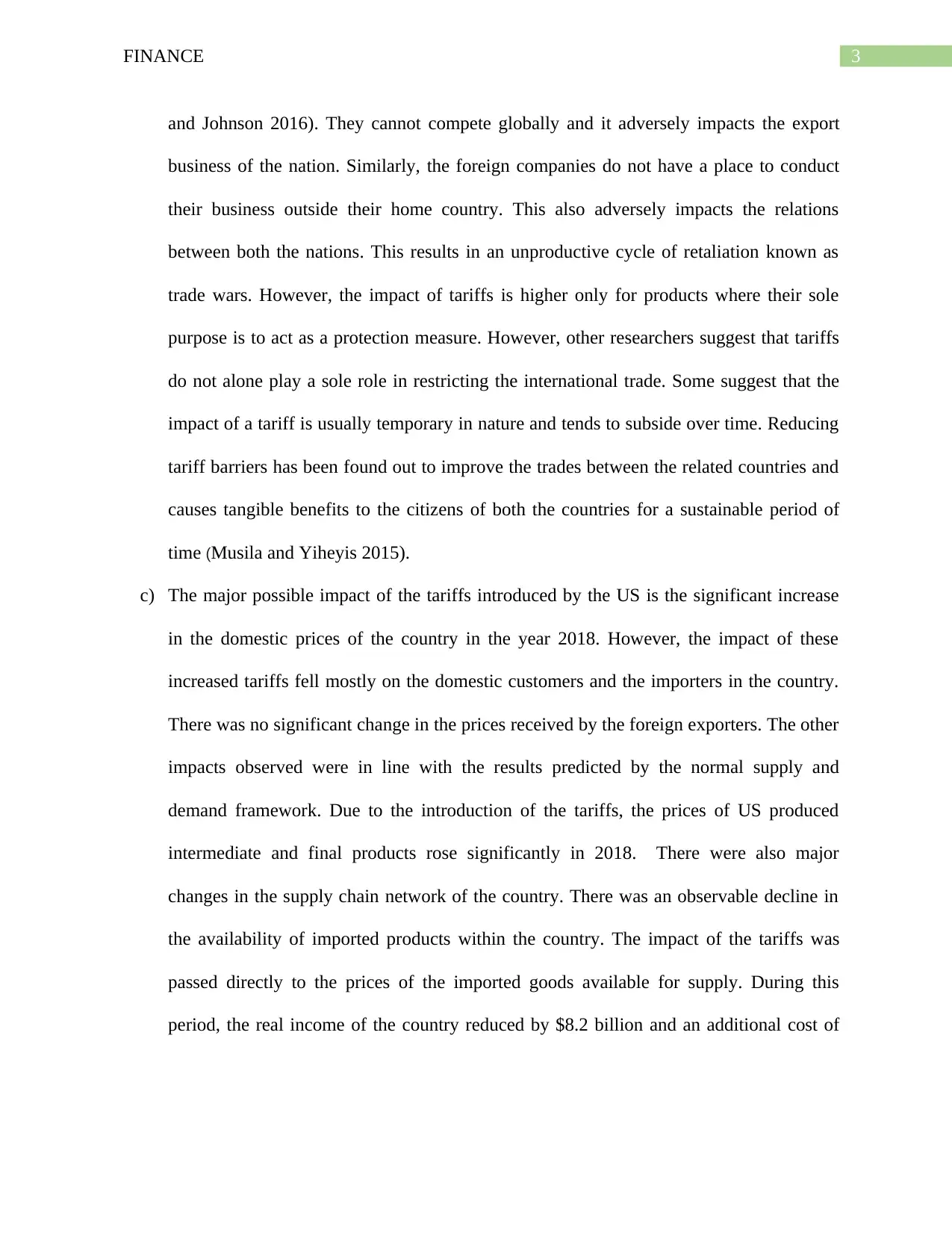
3FINANCE
and Johnson 2016). They cannot compete globally and it adversely impacts the export
business of the nation. Similarly, the foreign companies do not have a place to conduct
their business outside their home country. This also adversely impacts the relations
between both the nations. This results in an unproductive cycle of retaliation known as
trade wars. However, the impact of tariffs is higher only for products where their sole
purpose is to act as a protection measure. However, other researchers suggest that tariffs
do not alone play a sole role in restricting the international trade. Some suggest that the
impact of a tariff is usually temporary in nature and tends to subside over time. Reducing
tariff barriers has been found out to improve the trades between the related countries and
causes tangible benefits to the citizens of both the countries for a sustainable period of
time (Musila and Yiheyis 2015).
c) The major possible impact of the tariffs introduced by the US is the significant increase
in the domestic prices of the country in the year 2018. However, the impact of these
increased tariffs fell mostly on the domestic customers and the importers in the country.
There was no significant change in the prices received by the foreign exporters. The other
impacts observed were in line with the results predicted by the normal supply and
demand framework. Due to the introduction of the tariffs, the prices of US produced
intermediate and final products rose significantly in 2018. There were also major
changes in the supply chain network of the country. There was an observable decline in
the availability of imported products within the country. The impact of the tariffs was
passed directly to the prices of the imported goods available for supply. During this
period, the real income of the country reduced by $8.2 billion and an additional cost of
and Johnson 2016). They cannot compete globally and it adversely impacts the export
business of the nation. Similarly, the foreign companies do not have a place to conduct
their business outside their home country. This also adversely impacts the relations
between both the nations. This results in an unproductive cycle of retaliation known as
trade wars. However, the impact of tariffs is higher only for products where their sole
purpose is to act as a protection measure. However, other researchers suggest that tariffs
do not alone play a sole role in restricting the international trade. Some suggest that the
impact of a tariff is usually temporary in nature and tends to subside over time. Reducing
tariff barriers has been found out to improve the trades between the related countries and
causes tangible benefits to the citizens of both the countries for a sustainable period of
time (Musila and Yiheyis 2015).
c) The major possible impact of the tariffs introduced by the US is the significant increase
in the domestic prices of the country in the year 2018. However, the impact of these
increased tariffs fell mostly on the domestic customers and the importers in the country.
There was no significant change in the prices received by the foreign exporters. The other
impacts observed were in line with the results predicted by the normal supply and
demand framework. Due to the introduction of the tariffs, the prices of US produced
intermediate and final products rose significantly in 2018. There were also major
changes in the supply chain network of the country. There was an observable decline in
the availability of imported products within the country. The impact of the tariffs was
passed directly to the prices of the imported goods available for supply. During this
period, the real income of the country reduced by $8.2 billion and an additional cost of
Paraphrase This Document
Need a fresh take? Get an instant paraphrase of this document with our AI Paraphraser
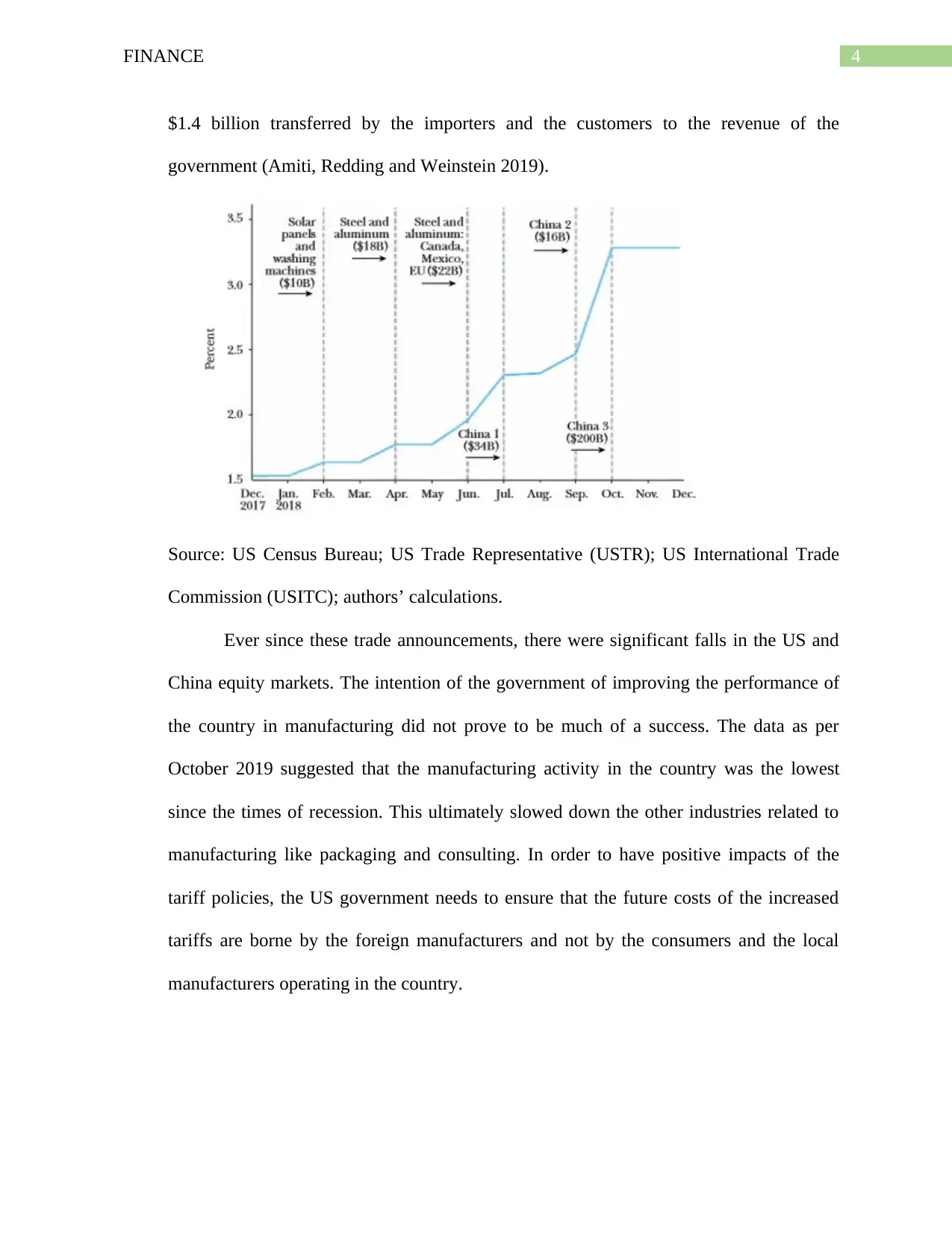
4FINANCE
$1.4 billion transferred by the importers and the customers to the revenue of the
government (Amiti, Redding and Weinstein 2019).
Source: US Census Bureau; US Trade Representative (USTR); US International Trade
Commission (USITC); authors’ calculations.
Ever since these trade announcements, there were significant falls in the US and
China equity markets. The intention of the government of improving the performance of
the country in manufacturing did not prove to be much of a success. The data as per
October 2019 suggested that the manufacturing activity in the country was the lowest
since the times of recession. This ultimately slowed down the other industries related to
manufacturing like packaging and consulting. In order to have positive impacts of the
tariff policies, the US government needs to ensure that the future costs of the increased
tariffs are borne by the foreign manufacturers and not by the consumers and the local
manufacturers operating in the country.
$1.4 billion transferred by the importers and the customers to the revenue of the
government (Amiti, Redding and Weinstein 2019).
Source: US Census Bureau; US Trade Representative (USTR); US International Trade
Commission (USITC); authors’ calculations.
Ever since these trade announcements, there were significant falls in the US and
China equity markets. The intention of the government of improving the performance of
the country in manufacturing did not prove to be much of a success. The data as per
October 2019 suggested that the manufacturing activity in the country was the lowest
since the times of recession. This ultimately slowed down the other industries related to
manufacturing like packaging and consulting. In order to have positive impacts of the
tariff policies, the US government needs to ensure that the future costs of the increased
tariffs are borne by the foreign manufacturers and not by the consumers and the local
manufacturers operating in the country.
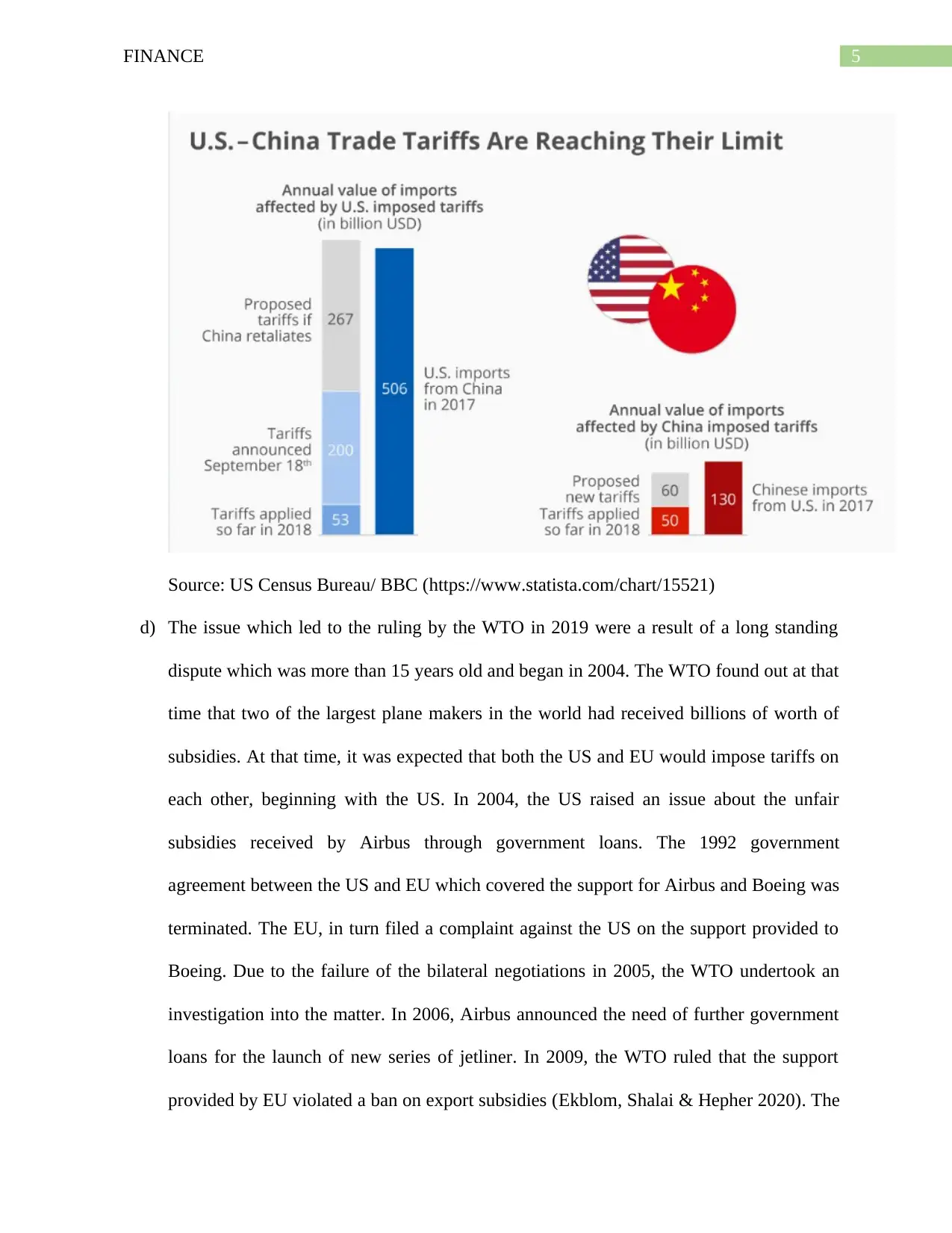
5FINANCE
Source: US Census Bureau/ BBC (https://www.statista.com/chart/15521)
d) The issue which led to the ruling by the WTO in 2019 were a result of a long standing
dispute which was more than 15 years old and began in 2004. The WTO found out at that
time that two of the largest plane makers in the world had received billions of worth of
subsidies. At that time, it was expected that both the US and EU would impose tariffs on
each other, beginning with the US. In 2004, the US raised an issue about the unfair
subsidies received by Airbus through government loans. The 1992 government
agreement between the US and EU which covered the support for Airbus and Boeing was
terminated. The EU, in turn filed a complaint against the US on the support provided to
Boeing. Due to the failure of the bilateral negotiations in 2005, the WTO undertook an
investigation into the matter. In 2006, Airbus announced the need of further government
loans for the launch of new series of jetliner. In 2009, the WTO ruled that the support
provided by EU violated a ban on export subsidies (Ekblom, Shalai & Hepher 2020). The
Source: US Census Bureau/ BBC (https://www.statista.com/chart/15521)
d) The issue which led to the ruling by the WTO in 2019 were a result of a long standing
dispute which was more than 15 years old and began in 2004. The WTO found out at that
time that two of the largest plane makers in the world had received billions of worth of
subsidies. At that time, it was expected that both the US and EU would impose tariffs on
each other, beginning with the US. In 2004, the US raised an issue about the unfair
subsidies received by Airbus through government loans. The 1992 government
agreement between the US and EU which covered the support for Airbus and Boeing was
terminated. The EU, in turn filed a complaint against the US on the support provided to
Boeing. Due to the failure of the bilateral negotiations in 2005, the WTO undertook an
investigation into the matter. In 2006, Airbus announced the need of further government
loans for the launch of new series of jetliner. In 2009, the WTO ruled that the support
provided by EU violated a ban on export subsidies (Ekblom, Shalai & Hepher 2020). The
⊘ This is a preview!⊘
Do you want full access?
Subscribe today to unlock all pages.

Trusted by 1+ million students worldwide
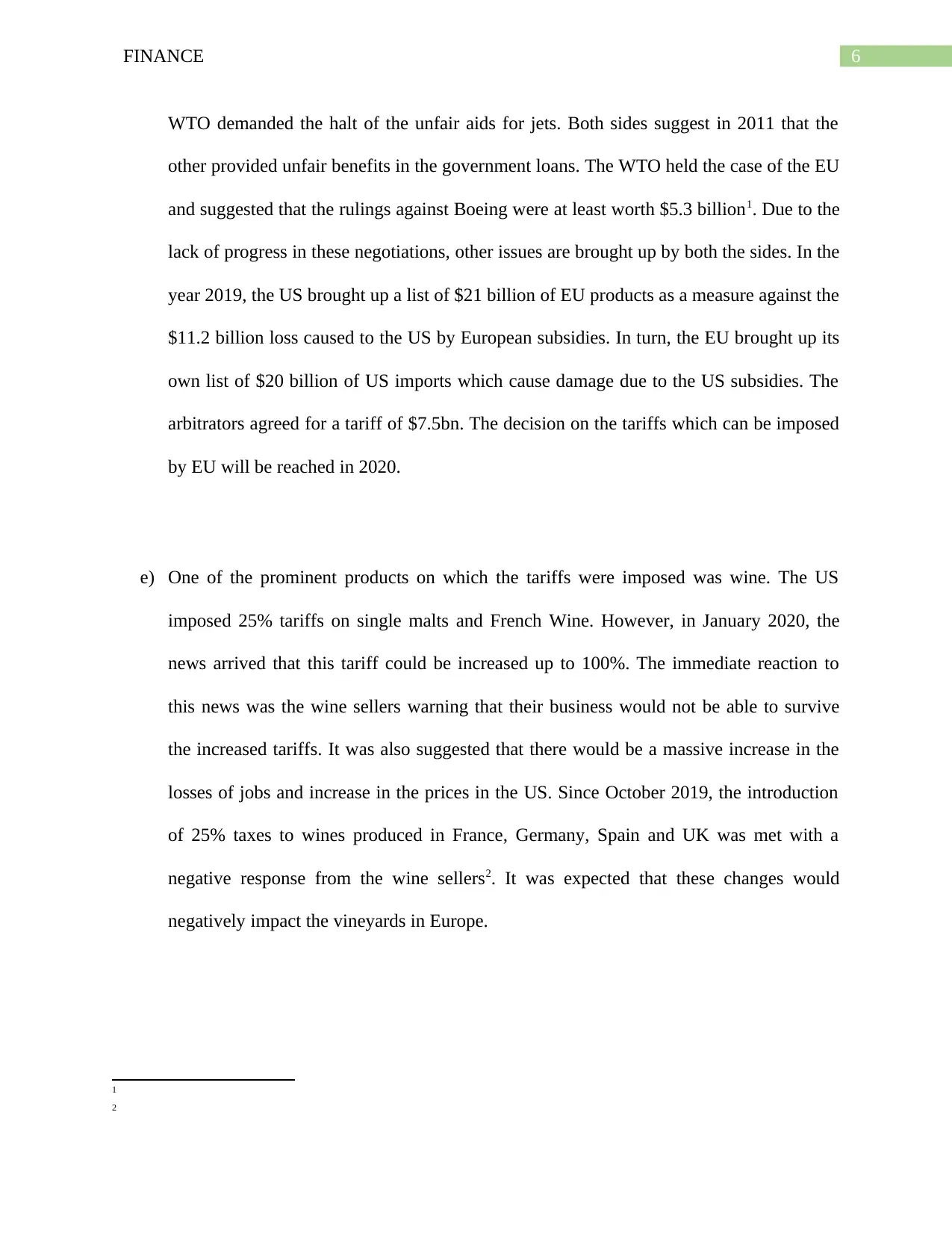
6FINANCE
WTO demanded the halt of the unfair aids for jets. Both sides suggest in 2011 that the
other provided unfair benefits in the government loans. The WTO held the case of the EU
and suggested that the rulings against Boeing were at least worth $5.3 billion1. Due to the
lack of progress in these negotiations, other issues are brought up by both the sides. In the
year 2019, the US brought up a list of $21 billion of EU products as a measure against the
$11.2 billion loss caused to the US by European subsidies. In turn, the EU brought up its
own list of $20 billion of US imports which cause damage due to the US subsidies. The
arbitrators agreed for a tariff of $7.5bn. The decision on the tariffs which can be imposed
by EU will be reached in 2020.
e) One of the prominent products on which the tariffs were imposed was wine. The US
imposed 25% tariffs on single malts and French Wine. However, in January 2020, the
news arrived that this tariff could be increased up to 100%. The immediate reaction to
this news was the wine sellers warning that their business would not be able to survive
the increased tariffs. It was also suggested that there would be a massive increase in the
losses of jobs and increase in the prices in the US. Since October 2019, the introduction
of 25% taxes to wines produced in France, Germany, Spain and UK was met with a
negative response from the wine sellers2. It was expected that these changes would
negatively impact the vineyards in Europe.
1
2
WTO demanded the halt of the unfair aids for jets. Both sides suggest in 2011 that the
other provided unfair benefits in the government loans. The WTO held the case of the EU
and suggested that the rulings against Boeing were at least worth $5.3 billion1. Due to the
lack of progress in these negotiations, other issues are brought up by both the sides. In the
year 2019, the US brought up a list of $21 billion of EU products as a measure against the
$11.2 billion loss caused to the US by European subsidies. In turn, the EU brought up its
own list of $20 billion of US imports which cause damage due to the US subsidies. The
arbitrators agreed for a tariff of $7.5bn. The decision on the tariffs which can be imposed
by EU will be reached in 2020.
e) One of the prominent products on which the tariffs were imposed was wine. The US
imposed 25% tariffs on single malts and French Wine. However, in January 2020, the
news arrived that this tariff could be increased up to 100%. The immediate reaction to
this news was the wine sellers warning that their business would not be able to survive
the increased tariffs. It was also suggested that there would be a massive increase in the
losses of jobs and increase in the prices in the US. Since October 2019, the introduction
of 25% taxes to wines produced in France, Germany, Spain and UK was met with a
negative response from the wine sellers2. It was expected that these changes would
negatively impact the vineyards in Europe.
1
2
Paraphrase This Document
Need a fresh take? Get an instant paraphrase of this document with our AI Paraphraser
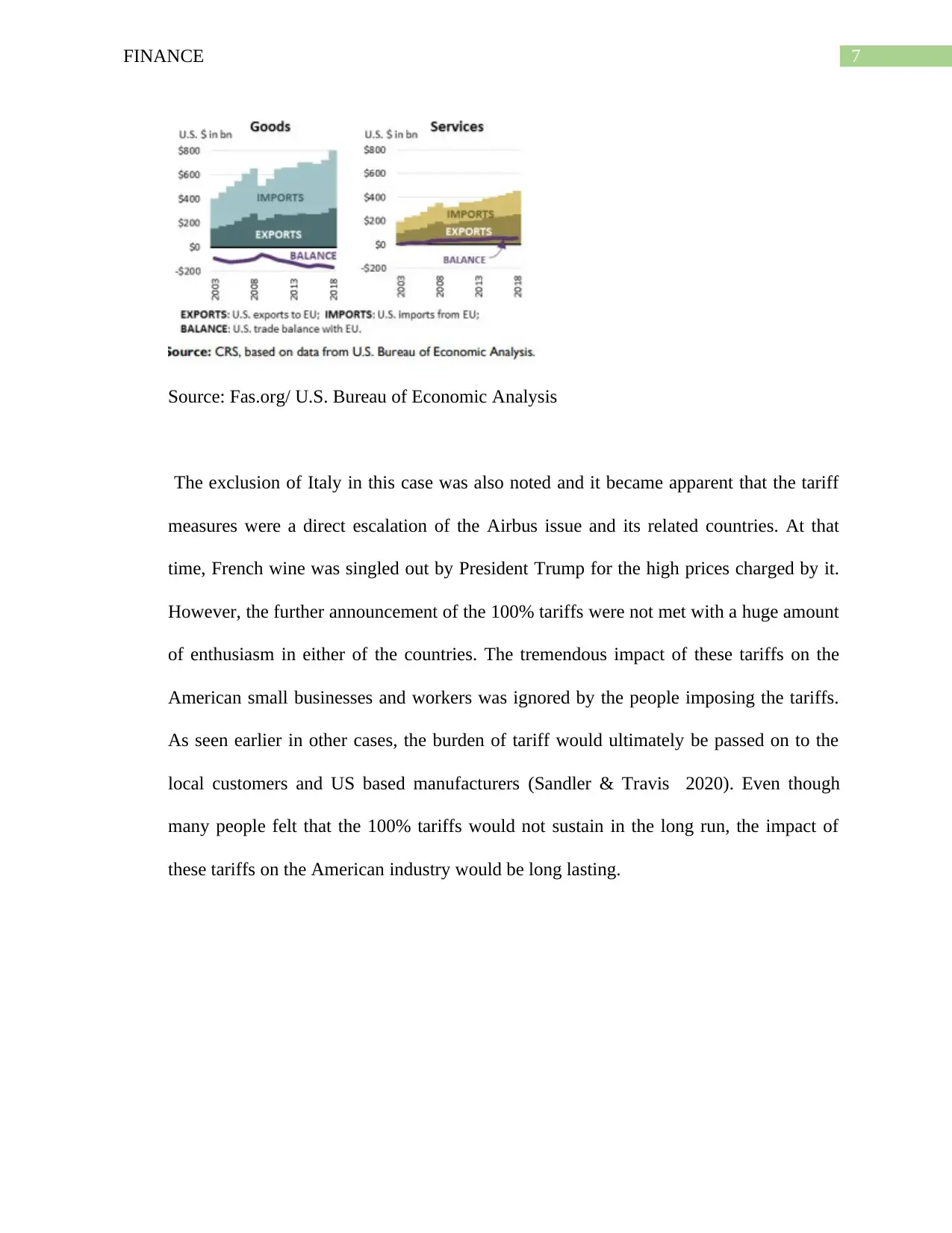
7FINANCE
Source: Fas.org/ U.S. Bureau of Economic Analysis
The exclusion of Italy in this case was also noted and it became apparent that the tariff
measures were a direct escalation of the Airbus issue and its related countries. At that
time, French wine was singled out by President Trump for the high prices charged by it.
However, the further announcement of the 100% tariffs were not met with a huge amount
of enthusiasm in either of the countries. The tremendous impact of these tariffs on the
American small businesses and workers was ignored by the people imposing the tariffs.
As seen earlier in other cases, the burden of tariff would ultimately be passed on to the
local customers and US based manufacturers (Sandler & Travis 2020). Even though
many people felt that the 100% tariffs would not sustain in the long run, the impact of
these tariffs on the American industry would be long lasting.
Source: Fas.org/ U.S. Bureau of Economic Analysis
The exclusion of Italy in this case was also noted and it became apparent that the tariff
measures were a direct escalation of the Airbus issue and its related countries. At that
time, French wine was singled out by President Trump for the high prices charged by it.
However, the further announcement of the 100% tariffs were not met with a huge amount
of enthusiasm in either of the countries. The tremendous impact of these tariffs on the
American small businesses and workers was ignored by the people imposing the tariffs.
As seen earlier in other cases, the burden of tariff would ultimately be passed on to the
local customers and US based manufacturers (Sandler & Travis 2020). Even though
many people felt that the 100% tariffs would not sustain in the long run, the impact of
these tariffs on the American industry would be long lasting.
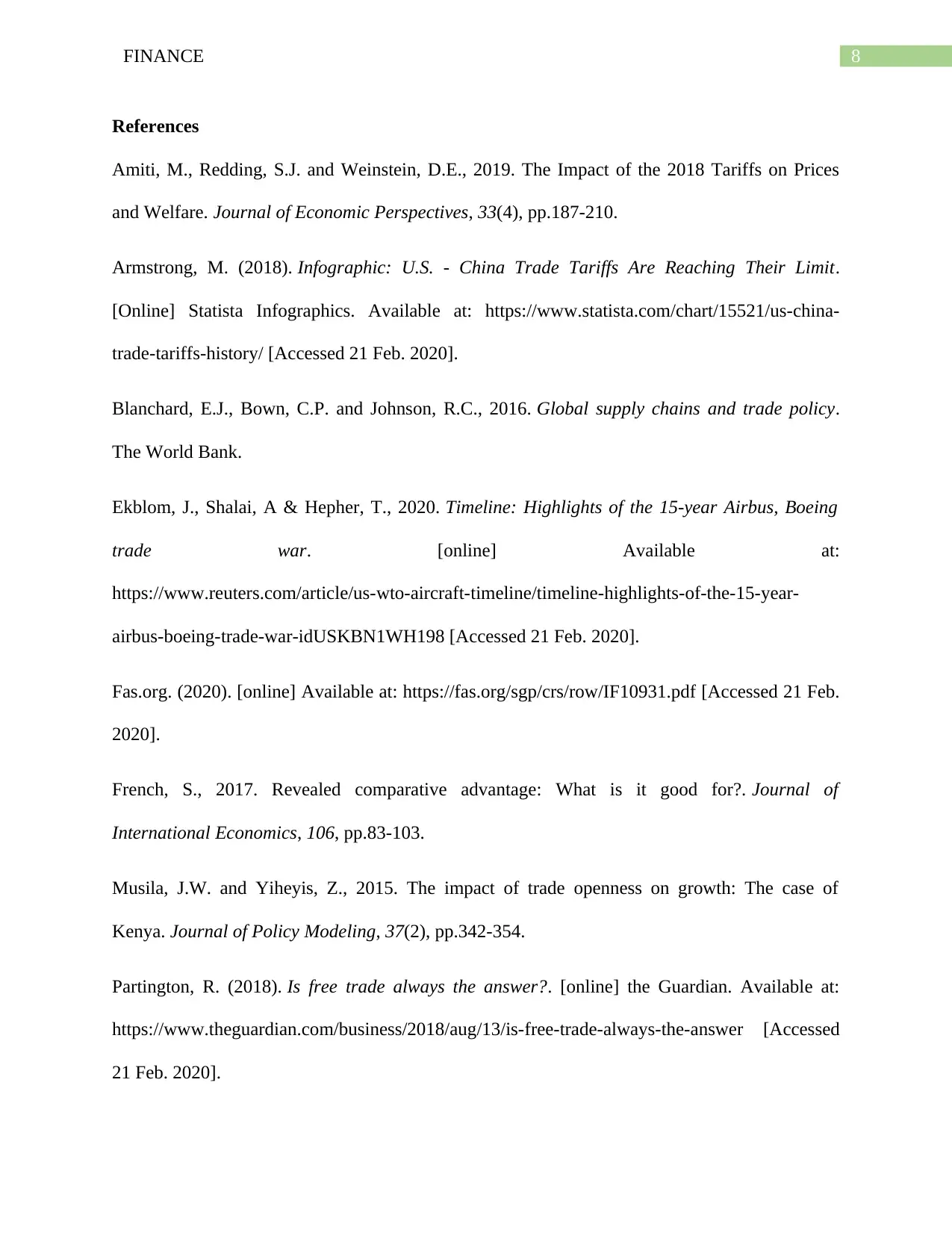
8FINANCE
References
Amiti, M., Redding, S.J. and Weinstein, D.E., 2019. The Impact of the 2018 Tariffs on Prices
and Welfare. Journal of Economic Perspectives, 33(4), pp.187-210.
Armstrong, M. (2018). Infographic: U.S. - China Trade Tariffs Are Reaching Their Limit.
[Online] Statista Infographics. Available at: https://www.statista.com/chart/15521/us-china-
trade-tariffs-history/ [Accessed 21 Feb. 2020].
Blanchard, E.J., Bown, C.P. and Johnson, R.C., 2016. Global supply chains and trade policy.
The World Bank.
Ekblom, J., Shalai, A & Hepher, T., 2020. Timeline: Highlights of the 15-year Airbus, Boeing
trade war. [online] Available at:
https://www.reuters.com/article/us-wto-aircraft-timeline/timeline-highlights-of-the-15-year-
airbus-boeing-trade-war-idUSKBN1WH198 [Accessed 21 Feb. 2020].
Fas.org. (2020). [online] Available at: https://fas.org/sgp/crs/row/IF10931.pdf [Accessed 21 Feb.
2020].
French, S., 2017. Revealed comparative advantage: What is it good for?. Journal of
International Economics, 106, pp.83-103.
Musila, J.W. and Yiheyis, Z., 2015. The impact of trade openness on growth: The case of
Kenya. Journal of Policy Modeling, 37(2), pp.342-354.
Partington, R. (2018). Is free trade always the answer?. [online] the Guardian. Available at:
https://www.theguardian.com/business/2018/aug/13/is-free-trade-always-the-answer [Accessed
21 Feb. 2020].
References
Amiti, M., Redding, S.J. and Weinstein, D.E., 2019. The Impact of the 2018 Tariffs on Prices
and Welfare. Journal of Economic Perspectives, 33(4), pp.187-210.
Armstrong, M. (2018). Infographic: U.S. - China Trade Tariffs Are Reaching Their Limit.
[Online] Statista Infographics. Available at: https://www.statista.com/chart/15521/us-china-
trade-tariffs-history/ [Accessed 21 Feb. 2020].
Blanchard, E.J., Bown, C.P. and Johnson, R.C., 2016. Global supply chains and trade policy.
The World Bank.
Ekblom, J., Shalai, A & Hepher, T., 2020. Timeline: Highlights of the 15-year Airbus, Boeing
trade war. [online] Available at:
https://www.reuters.com/article/us-wto-aircraft-timeline/timeline-highlights-of-the-15-year-
airbus-boeing-trade-war-idUSKBN1WH198 [Accessed 21 Feb. 2020].
Fas.org. (2020). [online] Available at: https://fas.org/sgp/crs/row/IF10931.pdf [Accessed 21 Feb.
2020].
French, S., 2017. Revealed comparative advantage: What is it good for?. Journal of
International Economics, 106, pp.83-103.
Musila, J.W. and Yiheyis, Z., 2015. The impact of trade openness on growth: The case of
Kenya. Journal of Policy Modeling, 37(2), pp.342-354.
Partington, R. (2018). Is free trade always the answer?. [online] the Guardian. Available at:
https://www.theguardian.com/business/2018/aug/13/is-free-trade-always-the-answer [Accessed
21 Feb. 2020].
⊘ This is a preview!⊘
Do you want full access?
Subscribe today to unlock all pages.

Trusted by 1+ million students worldwide
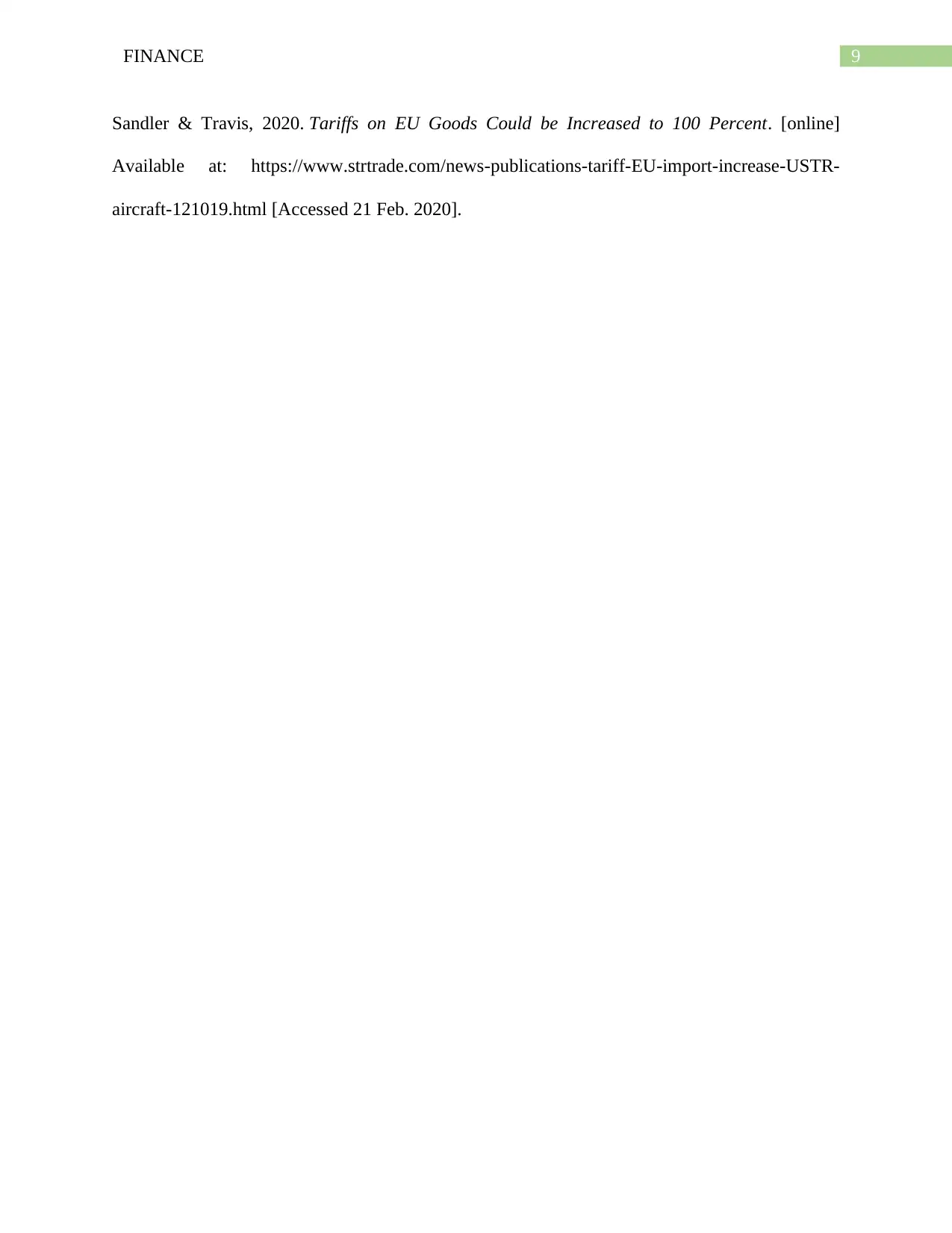
9FINANCE
Sandler & Travis, 2020. Tariffs on EU Goods Could be Increased to 100 Percent. [online]
Available at: https://www.strtrade.com/news-publications-tariff-EU-import-increase-USTR-
aircraft-121019.html [Accessed 21 Feb. 2020].
Sandler & Travis, 2020. Tariffs on EU Goods Could be Increased to 100 Percent. [online]
Available at: https://www.strtrade.com/news-publications-tariff-EU-import-increase-USTR-
aircraft-121019.html [Accessed 21 Feb. 2020].
1 out of 10
Related Documents
Your All-in-One AI-Powered Toolkit for Academic Success.
+13062052269
info@desklib.com
Available 24*7 on WhatsApp / Email
![[object Object]](/_next/static/media/star-bottom.7253800d.svg)
Unlock your academic potential
Copyright © 2020–2025 A2Z Services. All Rights Reserved. Developed and managed by ZUCOL.





